语言学样题及答案
- 格式:doc
- 大小:108.00 KB
- 文档页数:17
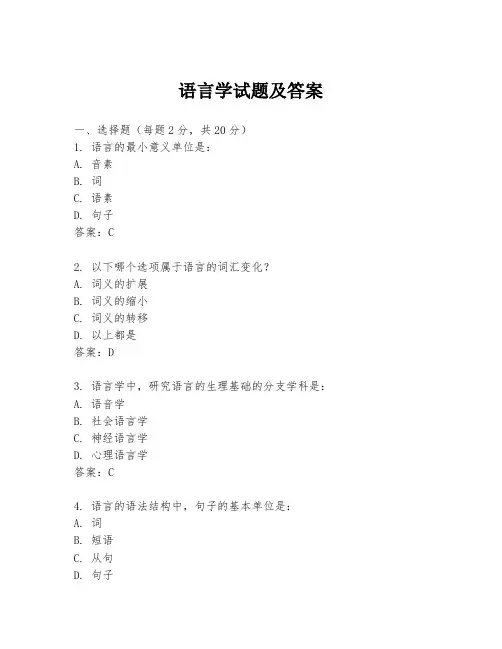
语言学试题及答案一、选择题(每题2分,共20分)1. 语言的最小意义单位是:A. 音素B. 词C. 语素D. 句子答案:C2. 以下哪个选项属于语言的词汇变化?A. 词义的扩展B. 词义的缩小C. 词义的转移D. 以上都是答案:D3. 语言学中,研究语言的生理基础的分支学科是:A. 语音学B. 社会语言学C. 神经语言学D. 心理语言学答案:C4. 语言的语法结构中,句子的基本单位是:A. 词B. 短语C. 从句D. 句子答案:A5. 以下哪个选项不属于语言的交际功能?A. 表达情感B. 传递信息C. 娱乐消遣D. 记录历史答案:D6. 语言学中,研究语言在社会中如何使用和变化的分支学科是:A. 社会语言学B. 历史语言学C. 心理语言学D. 神经语言学答案:A7. 语言的语用学研究的是:A. 语言的物理属性B. 语言的社会属性C. 语言的意义和使用D. 语言的历史发展答案:C8. 以下哪个选项是语言的语音变化?A. 音位的变化B. 音节的变化C. 音素的变化D. 以上都是答案:D9. 语言学中,研究语言与思维关系的分支学科是:A. 心理语言学B. 社会语言学C. 神经语言学D. 认知语言学答案:D10. 以下哪个选项是语言的词汇创新?A. 新词的产生B. 旧词的消失C. 词义的演变D. 以上都是答案:D二、填空题(每题2分,共20分)1. 语言的音位变化通常包括音位的______、______和______。
答案:增加、减少、替换2. 语言的词汇变化可以通过______、______和______等方式实现。
答案:创造新词、借用外来词、词义演变3. 语言的语法结构中,______是构成句子的基本单位。
答案:词4. 语言的交际功能包括______、______和______等。
答案:表达思想、传递信息、表达情感5. 语言学中,______是研究语言的物理属性的分支学科。
答案:语音学6. 语言的语用学关注的是语言的______和______。
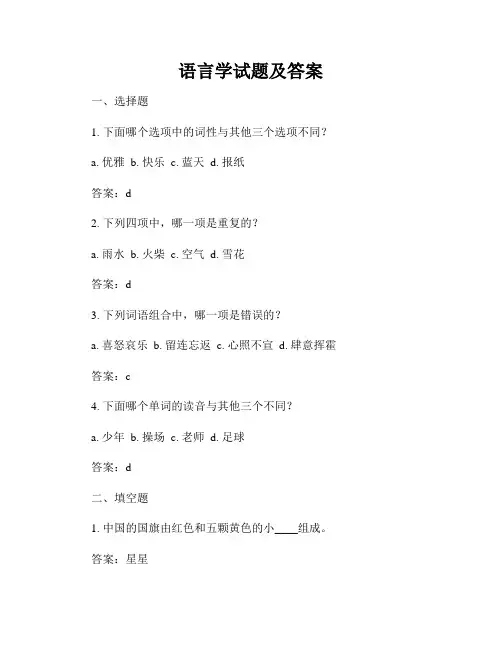
语言学试题及答案一、选择题1. 下面哪个选项中的词性与其他三个选项不同?a. 优雅b. 快乐c. 蓝天d. 报纸答案:d2. 下列四项中,哪一项是重复的?a. 雨水b. 火柴c. 空气d. 雪花答案:d3. 下列词语组合中,哪一项是错误的?a. 喜怒哀乐b. 留连忘返c. 心照不宣d. 肆意挥霍答案:c4. 下面哪个单词的读音与其他三个不同?a. 少年b. 操场c. 老师d. 足球答案:d二、填空题1. 中国的国旗由红色和五颗黄色的小____组成。
答案:星星2. 他用墨水和毛笔在纸上写了一首____。
答案:诗3. “一带一路”是中国提出的倡议,旨在促进国际____和____的发展。
答案:合作;交流4. 我们应该____帮助别人,不要只顾自己。
答案:无私地三、解答题1. 请简要解释“词义辨析”是什么,并举例说明。
答:词义辨析是指对多个在形式上相似但在义项上有差别的词语进行区分和辨析的过程。
这种辨析可以从词语的释义、上下文语境等方面进行。
例如,区分“优秀”和“杰出”这两个词语,可以通过它们的释义和用法来进行辨析。
我们可以说一个学生在学习方面表现优秀,而在体育方面表现杰出。
这样,通过了解这两个词语的不同义项和上下文语境,我们可以准确使用它们。
2. 请简要解释“歧义”是什么,并举例说明。
答:歧义是指一个词语、短语、句子等由于表达不清或具有多种理解方式而产生的模糊性。
在语言学中,歧义可能出现在词语的意义模糊、句子结构不明确等方面。
例如,“这个苹果真甜”,如果没有上下文,我们无法确定是指这个苹果很好吃,还是指对方很甜。
因此,在正式的语言交流中,我们要尽量避免歧义,保证信息的准确传达。
3. 请简要解释“同义词”和“反义词”的概念,并分别举例说明。
答:同义词是指在词义上相近或相同的词语。
它们在表达某个概念、感情或描述时,有着相似的意义。
例如,“美丽”和“漂亮”就是常见的同义词,它们在形容人或事物外表时意思相近。
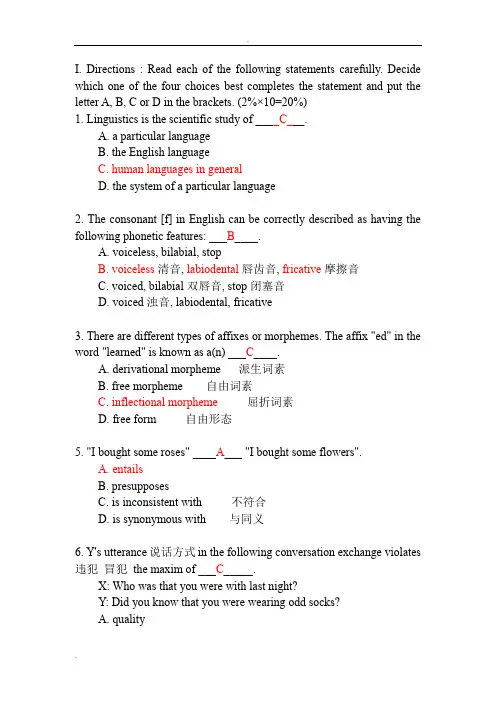
I. Directions : Read each of the following statements carefully. Decide which one of the four choices best completes the statement and put the letter A, B, C or D in the brackets. (2%×10=20%)1. Linguistics is the scientific study of ____C___.A. a particular languageB. the English languageC. human languages in generalD. the system of a particular language2. The consonant [f] in English can be correctly described as having the following phonetic features: ___B____.A. voiceless, bilabial, stopB. voiceless清音, labiodental唇齿音, fricative摩擦音C. voiced, bilabial双唇音, stop闭塞音D. voiced浊音, labiodental, fricative3. There are different types of affixes or morphemes. The affix "ed" in the word "learned" is known as a(n) ___C____.A. derivational morpheme 派生词素B. free morpheme 自由词素C. inflectional morpheme 屈折词素D. free form 自由形态5. "I bought some roses" ____A___ "I bought some flowers".A. entailsB. presupposesC. is inconsistent with 不符合D. is synonymous with 与同义6. Y's utterance说话方式in the following conversation exchange violates 违犯冒犯the maxim of ___C_____.X: Who was that you were with last night?Y: Did you know that you were wearing odd socks?A. qualityB. quantityC. relationD. manner7. Changes in a language are changes in the grammar of the speakers of the language. This means that phonemes, ____C___, words and grammatical rules may be borrowed外来词, added, lost or altered改变.A. phrases 短语B. sentencesC. morphemes 词素D. utterances 话语8. Predication analysis 预测分析is a way to analyze ___D__ meaning.A. phonemeB. wordC. phraseD. sentence9.According to Searle,those illocutionary acts言外行为whose point is to commit承诺the speaker to some future course of action are called __A __.A. commisives 承诺类B. directives 指令类C. expressives 表达类D. declaratives 宣告类18. The famous quotation from Shakespeare’s play “Romeo and Juliet” ‘A rose by any othername would smell as sweet’ well illustrates __A_.A. the conventional 传统性nature of languageB. the creative nature of languageC. the universality of language 普遍性D. the arbitrariness of language19. Of the following sound combinations,only ___A____ is permissible 可允许的according to thesequential rules in English.A. kiblB. bkilC. ilkbD. ilbk20. Syntax句法学is the study of___B_____。
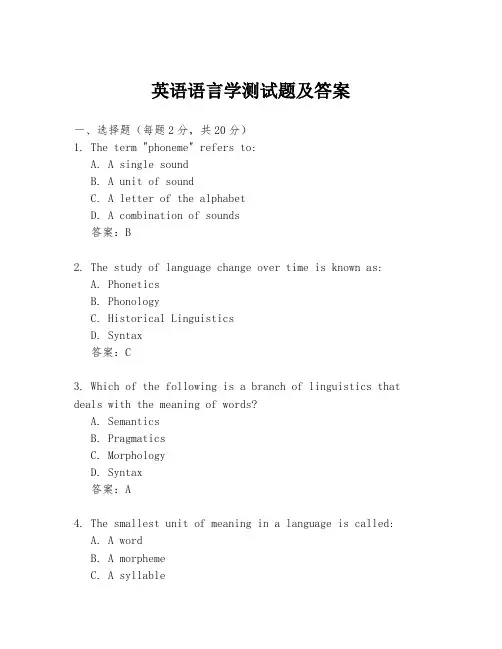
英语语言学测试题及答案一、选择题(每题2分,共20分)1. The term "phoneme" refers to:A. A single soundB. A unit of soundC. A letter of the alphabetD. A combination of sounds答案:B2. The study of language change over time is known as:A. PhoneticsB. PhonologyC. Historical LinguisticsD. Syntax答案:C3. Which of the following is a branch of linguistics that deals with the meaning of words?A. SemanticsB. PragmaticsC. MorphologyD. Syntax答案:A4. The smallest unit of meaning in a language is called:A. A wordB. A morphemeC. A syllableD. A phoneme答案:B5. The process of forming words by combining smaller units is known as:A. SyntaxB. MorphologyC. SemanticsD. Phonology答案:B6. The study of the rules governing the structure of sentences is called:A. SyntaxB. SemanticsC. PragmaticsD. Morphology答案:A7. The branch of linguistics that deals with the social context in which language is used is:A. SociolinguisticsB. PsycholinguisticsC. NeurolinguisticsD. Computational Linguistics答案:A8. The study of how language is processed in the brain is known as:A. PsycholinguisticsB. NeurolinguisticsC. SociolinguisticsD. Computational Linguistics答案:B9. The process of acquiring a first language is called:A. Second language acquisitionB. Foreign language learningC. Language learningD. First language acquisition答案:D10. The concept that language is arbitrary means that:A. It is randomB. It is meaninglessC. There is no necessary connection between the form of a word and its meaningD. It is always logical答案:C二、填空题(每题2分,共20分)1. The study of speech sounds is called ____________.答案:Phonetics2. The branch of linguistics that examines how language is used in social contexts is ____________.答案:Sociolinguistics3. The smallest meaningful unit of language is known as the ____________.答案:Morpheme4. The process of combining morphemes to form words is known as ____________.答案:Morphology5. The study of the way language is structured and organized is called ____________.答案:Linguistics6. The branch of linguistics that deals with the rules governing the formation of words is ____________.答案:Morphology7. The study of the way meaning is conveyed in language is known as ____________.答案:Semantics8. The branch of linguistics that deals with the rules governing the formation of sentences is ____________.答案:Syntax9. The study of the way language is used in everyday life is called ____________.答案:Pragmatics10. The study of the way language is processed in the brain is known as ____________.答案:Neurolinguistics三、简答题(每题10分,共40分)1. Explain the difference between phonetics and phonology.答案:Phonetics is the study of speech sounds and theirproduction, while phonology is the study of the sound system of a language, including the rules governing the use of these sounds.2. What is the Sapir-Whorf hypothesis?答案:The Sapir-Whorf hypothesis suggests that the language a person speaks influences the way they perceive the world and think.3. Describe the role of sociolinguistics in understanding language.答案:Sociolinguistics helps us understand how language varies with different social contexts, such as class, gender, ethnicity, and age, and how these variations influence language use.4. How does first language acquisition differ from second language acquisition?答案:First language acquisition is the process of learning a native language during early childhood, while second language acquisition is the process of learning a new language after the age of language development. The process of second language acquisition is influenced by the learner's first language and cognitive abilities.。
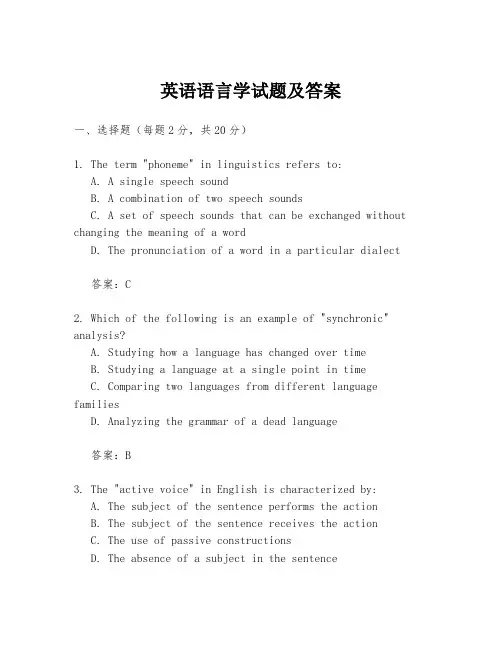
英语语言学试题及答案一、选择题(每题2分,共20分)1. The term "phoneme" in linguistics refers to:A. A single speech soundB. A combination of two speech soundsC. A set of speech sounds that can be exchanged without changing the meaning of a wordD. The pronunciation of a word in a particular dialect答案:C2. Which of the following is an example of "synchronic" analysis?A. Studying how a language has changed over timeB. Studying a language at a single point in timeC. Comparing two languages from different language familiesD. Analyzing the grammar of a dead language答案:B3. The "active voice" in English is characterized by:A. The subject of the sentence performs the actionB. The subject of the sentence receives the actionC. The use of passive constructionsD. The absence of a subject in the sentence答案:A4. Which of the following sentence structures is considered "inverse"?A. Subject-Verb-ObjectB. Object-Subject-VerbC. Verb-Object-SubjectD. Subject-Object-Verb答案:B5. The process of "creolization" results in the formation of:A. A pidginB. A dialectC. A creoleD. A standard language答案:C6. In English, the word "run" can function as:a. A nounb. A verbc. An adjectived. All of the above答案:D7. The term "register" refers to:A. The highest pitch a voice can reachB. A dialect used by a particular social groupC. The level of formality in language useD. A type of linguistic accent答案:C8. The "universal grammar" hypothesis was proposed by:A. Noam ChomskyB. B.F. SkinnerC. Ferdinand de SaussureD. Edward Sapir答案:A9. The "allophone" of the English phoneme /p/ in the word "spin" is:A. Aspirated [pʰ]B. Unaspirated [p]C. Voiced [b]D. Voiceless [p]答案:A10. The linguistic concept of "polysemy" refers to:A. The use of a single word to express multiple meaningsB. The use of multiple words to express a single meaningC. The change in meaning of a word over timeD. The complete replacement of one word by another答案:A二、填空题(每题2分,共20分)1. The study of language in relation to the brain and the nervous system is known as __________.答案:neurolinguistics2. A(n) __________ is a word that has a meaning and stands alone, typically consisting of a single morpheme.3. The __________ of a word is the set of words that are used together with it and influence its meaning.4. In linguistics, __________ refers to the smallest unit of meaning in a language.5. The __________ is the standard form of a verb that is typically used when conjugating the verb in the present tense.6. A(n) __________ is a word that is formed from a root word and one or more affixes.7. The __________ is the study of the historical developmentof languages.8. The __________ is the systematic study of the structureand function of words.9. The __________ is the study of the way in which languages change over time due to contact with other languages.10. The __________ is the branch of linguistics that studies the sounds of a language and how they function in a system ofcommunication.三、简答题(每题10分,共30分)1. 描述语音学中的“最小对立对”概念,并给出一个英语例子。
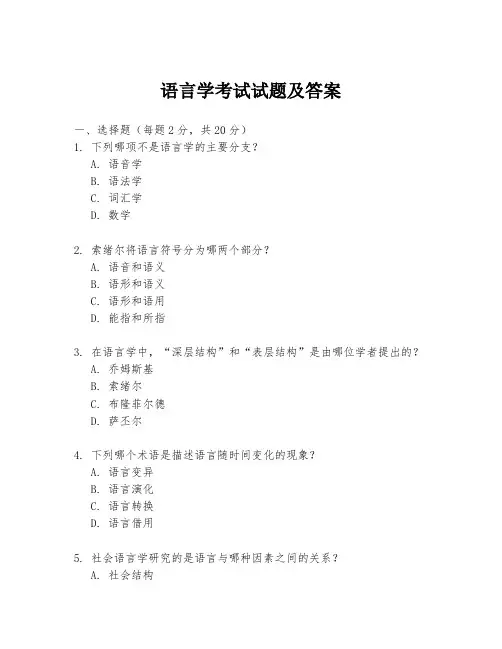
语言学考试试题及答案一、选择题(每题2分,共20分)1. 下列哪项不是语言学的主要分支?A. 语音学B. 语法学C. 词汇学D. 数学2. 索绪尔将语言符号分为哪两个部分?A. 语音和语义B. 语形和语义C. 语形和语用D. 能指和所指3. 在语言学中,“深层结构”和“表层结构”是由哪位学者提出的?A. 乔姆斯基B. 索绪尔C. 布隆菲尔德D. 萨丕尔4. 下列哪个术语是描述语言随时间变化的现象?A. 语言变异B. 语言演化C. 语言转换D. 语言借用5. 社会语言学研究的是语言与哪种因素之间的关系?A. 社会结构B. 文化传统C. 个人心理D. 经济发展6. 哪种语言现象是指在特定情境下,说话者选择不同语言或语言变体的能力?A. 语码转换B. 语码混用C. 语用学D. 语言礼貌7. 下列哪项不是语用学的研究内容?A. 言语行为B. 隐喻理解C. 语言礼貌D. 语言的生物学基础8. 什么是“双重否定”?A. 使用两个否定词来表达否定意义B. 使用两个否定词来表达肯定意义C. 使用一个否定词来表达否定意义D. 使用一个否定词来表达肯定意义9. 在语言学中,“同音词”是指什么?A. 意义相同但拼写不同的词B. 拼写相同但意义不同的词C. 发音相同但意义不同的词D. 发音和意义都相同的词10. 下列哪项是“语言接触”的一个例子?A. 语言的地理分布B. 语言的独立发展C. 语言的借用和融合D. 语言的孤立使用二、填空题(每题2分,共20分)11. 语言学中的“_______”是指研究语言的结构特征,不涉及语言的社会功能。
答案:形式语言学12. 转换生成语法是由_______提出的,它强调语言的生成能力。
答案:诺姆·乔姆斯基13. “Hello”一词在不同的语境中可以有不同的功能,这属于_______的研究范畴。
答案:语用学14. 社会语言学中的“_______”是指语言随社会因素(如年龄、性别、社会阶层等)而变化的现象。
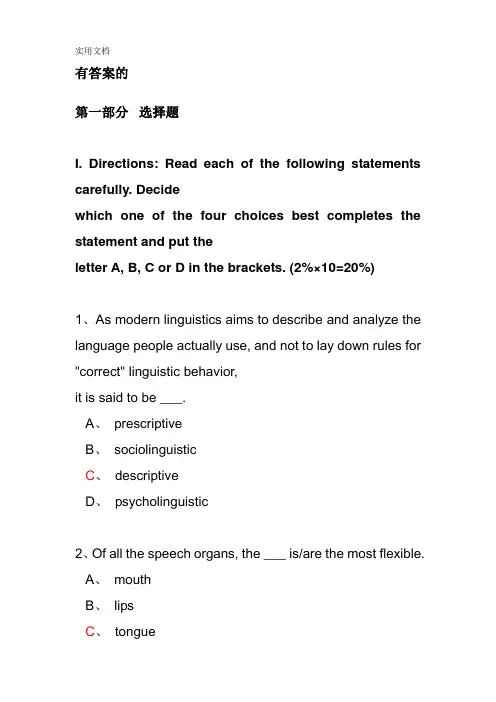
有答案的第一部分选择题I. Directions: Read each of the following statements carefully. Decidewhich one of the four choices best completes the statement and put theletter A, B, C or D in the brackets. (2%×10=20%)1、As modern linguistics aims to describe and analyze the language people actually use, and not to lay down rules for "correct" linguistic behavior,it is said to be ___.A、prescriptiveB、sociolinguisticC、descriptiveD、psycholinguistic2、Of all the speech organs, the ___ is/are the most flexible.A、mouthB、lipsC、tongueD、vocal cords3、The morpheme "vision" in the common word "television" is a(n) ___.A、bound morphemeB、bound formC、inflectional morphemeD、free morpheme4、A ___ in the embedded clause refers to the introductory word thatintroduces the embedded clause.A、coordinatorB、particleC、prepositionD、subordinator主从连词5、"Can I borrow your bike?" ___ "You have a bike."A、is synonymous withB、is inconsistent withC、entailsD、presupposes6、The branch of linguistics that studies how context influences the way speakers interpret sentences is called ___.A、semanticsB、pragmaticsC、sociolinguisticsD、psycholinguistics7、Grammatical changes may be explained, in part, as analogic changes, which are ___ or generalization泛化.A、elaborationB、simplification精简C、external borrowingD、internal borrowing8、___ refers to a marginal language of few lexical items and straightforward grammatical rules, used as a medium of communication.A、Lingua franca通用语B、CreoleC、PidginD、Standard language标准语言9、Psychologists, neurologists and linguists have concluded that, in addition to the motor area which is responsible for physical articulation of utterances, three areas of the left brain are vital to language, namely, ___ .A、Broca's area, Wernicke's area and the angular gyrus 角回B、Broca's area, Wernicke's area and cerebral cortexC、Broca's area, Wernicke's area and neuronsD、Broca's area, Wernicke's area and Exner's area10、According to Krashen, ___ refers to the gradual and subconcious development of ability in the first language by using it naturally in daily communicative situations.A、learningB、competenceC、performanceD、acquisition第二部分非选择题II. Directions: Fill in the blank in each of the following statements with one word, the first letter of which is already given as a clue. Note that you are to fill in One word only, and you are not allowed to change theletter given. (1%×10=10%)11、Chomsky defines "competence" as the ideal user'sk of the rules of his language.12、The four sounds /p/,/b/,/m/ and /w/have one feature in common, i.e, they are all b .13、M is a branch of grammar which studies the internal structure of words and the rules by which words are formed.14、A s is a structurally independent unit that usually comprises a number of words to form a completestatement, question or command.15、Synonyms that are mutually substitutable under allcircumstances are called c synonyms.16、The illocutionary point of r is to commit the speaker tosomething's being the case, to the truth of what has been said.17、Words are created outright to fit some purpose. Such a method of enlarging the vocabulary is known as word c .18、Wherever the standard language can use a contraction (he+is→he's), Black English can d the form of "be".19、The basic essentials of the first language are acquired in the short period from about age two to puberty, which is called the c period for first language acquisition.20、As a type of linguistic system in 12 learning, i is a product of L2 training, mother tongue intereference, overgeneralization of the target language rules, and learning and communicative strategies of the learner.III. Directions: Judge whether each of the following statements is true orfalse. Put a T for true or F for false in the brackets in front of eachstatement. If you think a statement is false, you must explain why youthink so and give the correct version. (2%×10=20%)()21、In modern linguistic studies, the written form of language is given more emphasis than the spoken form for a number of reasons.()22、Voicing is a phonological feature that distinguishes meaning in bothChinese and English.()23、The compound word "bookstore" is the place where books are sold. Thisindicates that the meaning of a compound is the sum total of the meaningsof its components.()24、Syntactic categories refer to sentences (S) and clauses (C) only.()25、Dialectal synonyms can often be found in differentregional dialectssuch as British English and American English but cannot be found withinthe variety itself, for example, within British English or AmericanEnglish.()26、Only when a maxim under Cooperative Principle is blatantly violatedand the hearer knows that it is being violated do conversationalimplicatures arise.()27、The territory in which the Indo-European languages are mainly spokentoday also includes languages that are not Indo-European.()28、In most bilingual communities, two languages have the same in speechsituations known as domains.()29、According to the strong version of the Sapir-Whorf hypothesis,speakers' perceptions determine language and pattern their way of life.()30、All normal children have equal ability to acquire their firstlanguage.IV. Directions: Explain the following terms, using one or two examples forillustration. (3%×10=30%)31、duality32、diachronic linguistics33、broad transcription34、morphological rules35、phrase structure rule36、relational opposites37、componential analysis38、context39、euphemism40、brain lateralizationV. Answer the following questions. (10%×2=20%)41、Explain how the inventory of sounds can change, giving some examples inEnglish for illustration.42、Briefly discuss the individual factors which affect the acquisition ofa second language.英语语言学试题(2)一、单项选择题(在每小题的四个备选答案中,选出一个正确答案,并将正确答案的序号填在题干的括号内。
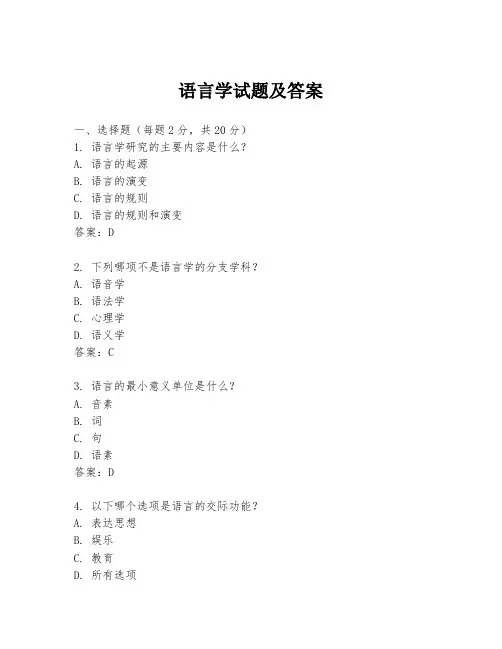
语言学试题及答案一、选择题(每题2分,共20分)1. 语言学研究的主要内容是什么?A. 语言的起源B. 语言的演变C. 语言的规则D. 语言的规则和演变答案:D2. 下列哪项不是语言学的分支学科?A. 语音学B. 语法学C. 心理学D. 语义学答案:C3. 语言的最小意义单位是什么?A. 音素B. 词C. 句D. 语素答案:D4. 以下哪个选项是语言的交际功能?A. 表达思想B. 娱乐C. 教育D. 所有选项答案:D5. 语言学中,研究语言的物理属性的学科是?A. 社会语言学B. 心理语言学C. 计算语言学D. 语音学答案:D6. 语言的“能指”指的是什么?A. 语言的声音B. 语言的意义C. 语言的书写形式D. 语言的语法结构答案:A7. 以下哪项属于语言的内部因素?A. 社会环境B. 历史发展C. 语言使用者D. 语言规则答案:D8. 语言的“所指”指的是什么?A. 语言的声音B. 语言的意义C. 语言的书写形式D. 语言的语法结构答案:B9. 语言的“共时研究”和“历时研究”分别指的是什么?A. 同时期的语言研究和不同时期语言的变化研究B. 语言的内部结构研究和语言的外部影响研究C. 语言的规则研究和语言的演变研究D. 语言的语法研究和语言的词汇研究答案:A10. 语言的“方言”和“土语”有何区别?A. 方言是大范围的地域性语言,土语是小范围的地域性语言B. 方言是小范围的地域性语言,土语是大范围的地域性语言C. 方言和土语没有区别D. 方言是书面语言,土语是口头语言答案:A二、填空题(每题2分,共20分)1. 语言学的四大分支包括语音学、语法学、语义学和______。
答案:语用学2. 语言的“词汇”是由一系列______组成的。
答案:词3. 语言的“句法”是指语言中词和词的组合规则。
答案:语法4. 语言的“语义”是指语言中的词和句子所表达的______。
答案:意义5. 语言学中,研究语言与社会的关系的学科是______。
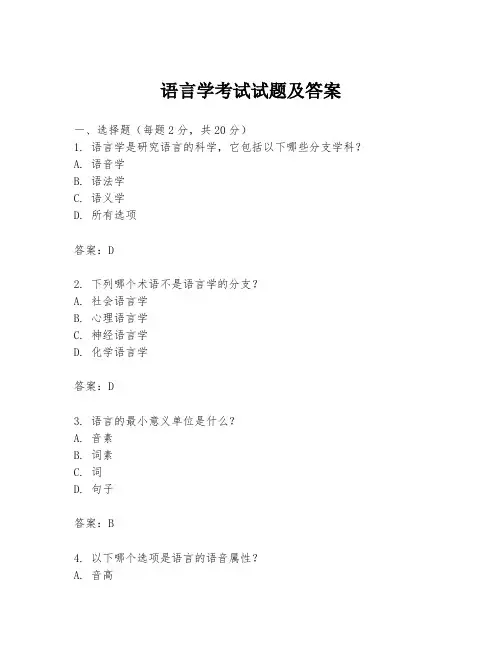
语言学考试试题及答案一、选择题(每题2分,共20分)1. 语言学是研究语言的科学,它包括以下哪些分支学科?A. 语音学B. 语法学C. 语义学D. 所有选项答案:D2. 下列哪个术语不是语言学的分支?A. 社会语言学B. 心理语言学C. 神经语言学D. 化学语言学答案:D3. 语言的最小意义单位是什么?A. 音素B. 词素C. 词D. 句子答案:B4. 以下哪个选项是语言的语音属性?A. 音高B. 音长C. 音色D. 所有选项答案:D5. 语言的语法规则可以是:A. 显性的B. 隐性的C. 两者都是D. 两者都不是答案:C6. 以下哪种语言现象不属于语言变异?A. 方言B. 社会方言C. 语言接触D. 语言消亡答案:D7. 语言的演变通常被认为是:A. 随机的B. 有目的的C. 无意识的D. 有意识的答案:C8. 语言接触可能导致:A. 语言融合B. 语言分离C. 语言借用D. 所有选项答案:D9. 语言的语用学研究的是:A. 语言的语境B. 语言的功能C. 语言的意义D. 所有选项答案:D10. 以下哪个术语不属于语义学研究的范围?A. 语义场B. 语义角色C. 语义关系D. 音位学答案:D二、填空题(每题2分,共20分)1. 语言的______属性包括音高、音长和音色。
答案:语音2. 语言的______属性包括语法、词汇和语义。
答案:结构3. 语言的______属性涉及语言的社会和文化方面。
答案:社会4. 语言学中的______理论认为语言是一系列规则的集合。
答案:形式主义5. 语言的______是语言学研究的基础单位。
答案:句子6. 语言的______是指语言在不同社会群体中的变体。
答案:变异7. 语言的______是指语言在不同地理区域的变体。
答案:方言8. 语言的______是指语言在不同时间的演变。
答案:历史9. 语言的______是指语言在不同语境中的使用。
答案:语用10. 语言的______是指语言的抽象意义。
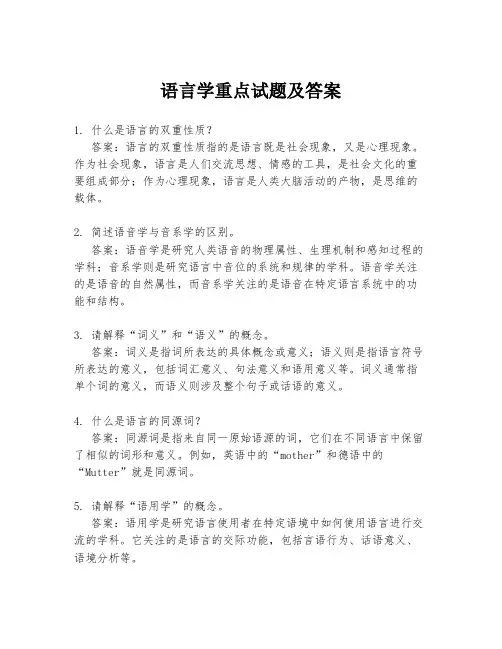
语言学重点试题及答案1. 什么是语言的双重性质?答案:语言的双重性质指的是语言既是社会现象,又是心理现象。
作为社会现象,语言是人们交流思想、情感的工具,是社会文化的重要组成部分;作为心理现象,语言是人类大脑活动的产物,是思维的载体。
2. 简述语音学与音系学的区别。
答案:语音学是研究人类语音的物理属性、生理机制和感知过程的学科;音系学则是研究语言中音位的系统和规律的学科。
语音学关注的是语音的自然属性,而音系学关注的是语音在特定语言系统中的功能和结构。
3. 请解释“词义”和“语义”的概念。
答案:词义是指词所表达的具体概念或意义;语义则是指语言符号所表达的意义,包括词汇意义、句法意义和语用意义等。
词义通常指单个词的意义,而语义则涉及整个句子或话语的意义。
4. 什么是语言的同源词?答案:同源词是指来自同一原始语源的词,它们在不同语言中保留了相似的词形和意义。
例如,英语中的“mother”和德语中的“Mutter”就是同源词。
5. 请解释“语用学”的概念。
答案:语用学是研究语言使用者在特定语境中如何使用语言进行交流的学科。
它关注的是语言的交际功能,包括言语行为、话语意义、语境分析等。
6. 什么是语言的方言?答案:方言是指在地理、社会或历史因素影响下形成的具有一定差异的语言变体。
方言通常与标准语或官方语言相对,它们在语音、词汇、语法等方面存在差异。
7. 简述语言的演变过程。
答案:语言的演变过程包括语音变化、词汇变化、语法变化等。
语音变化可能涉及音位的替换、合并或分化;词汇变化可能包括新词的产生、旧词的消亡或词义的演变;语法变化可能涉及句法结构的简化或复杂化。
8. 什么是语言的借词?答案:借词是指从一种语言借用到另一种语言的词汇。
借词通常是因为文化、经济或政治交流而产生的,它们可能在新语言中保留原有的发音和拼写,也可能发生适应性的变化。
9. 请解释“语言的谱系分类”。
答案:语言的谱系分类是根据语言之间的亲缘关系对语言进行分类的方法。
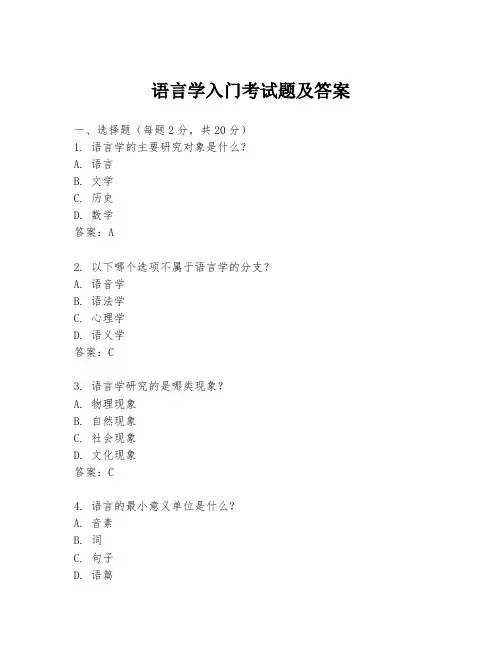
语言学入门考试题及答案一、选择题(每题2分,共20分)1. 语言学的主要研究对象是什么?A. 语言B. 文学C. 历史D. 数学答案:A2. 以下哪个选项不属于语言学的分支?A. 语音学B. 语法学C. 心理学D. 语义学答案:C3. 语言学研究的是哪类现象?A. 物理现象B. 自然现象C. 社会现象D. 文化现象答案:C4. 语言的最小意义单位是什么?A. 音素B. 词C. 句子D. 语篇答案:A5. 以下哪个术语不属于语言变异?A. 方言B. 社会方言C. 语言接触D. 语言死亡答案:D6. 语言的哪一层级负责表达意义?A. 语音层B. 语法层C. 语义层D. 语用层答案:C7. 以下哪个选项是语言的交际功能?A. 表达情感B. 描述事物C. 命令他人D. 所有选项答案:D8. 以下哪个选项是语言的内部结构?A. 音位B. 词汇C. 语音D. 语法答案:D9. 以下哪个选项是语言的外部功能?A. 信息传递B. 情感表达C. 命令控制D. 所有选项答案:D10. 语言的哪一层级负责表达关系?A. 语音层B. 语法层C. 语义层D. 语用层答案:B二、填空题(每题2分,共20分)1. 语言学研究的最小意义单位是________。
答案:音素2. 语言学研究的最小语音单位是________。
答案:音位3. 语言学研究的最小语法单位是________。
答案:词4. 语言学研究的最小语义单位是________。
答案:词义5. 语言学研究的最小语用单位是________。
答案:句子6. 语言学研究的最小社会单位是________。
答案:方言7. 语言学研究的最小文化单位是________。
答案:语言8. 语言学研究的最小交际单位是________。
答案:话语9. 语言学研究的最小心理单位是________。
答案:概念10. 语言学研究的最小认知单位是________。
答案:思维三、简答题(每题10分,共30分)1. 简述语言学的主要研究内容。
语言学试题及参考答案I. Directions : Read each of the following statements carefully. Decide which one of the four choices best completes the statement and put the letter A, B, C or D in the brackets. (2%×10=20%)1. Linguistics is the scientific study of __________.A. a particular languageB. the English languageC. human languages in generalD. the system of a particular language2. The consonant [f] in English can be correctly described as having the following phonetic features: __________.A. voiceless, bilabial, stopB. voiceless, labiodental, fricativeC. voiced, bilabial, stopD. voiced, labiodental, fricative3. There are different types of affixes or morphemes. The affix "ed" in the word "learned" is known as a(n) __________.A. derivational morphemeB. free morphemeC. inflectional morphemeD. free form4. In the phrase structure rule "S→NP VP", the arrow can be read as __________.A. is equal toB. consists ofC. hasD. generates5. "I bought some roses" __________ "I bought some flowers".A. entailsB. presupposesC. is inconsistent withD. is synonymous with6. Y's utterance in the following conversation exchange violates the maxim of __________.X: Who was that you were with last night?Y: Did you know that you were wearing odd socks?A. qualityB. quantityC. relationD. manne7. Changes in a language are changes in the grammar of the speakers of the language. This means that phonemes, __________, words and grammatical rules may be borrowed, added, lost or altered.A. phrasesB. sentencesC. morphemesD. utterances8. In a speech community people have something in common __________a language or a particular variety of language and rules for using it.A. sociallyB. linguisticallyC. culturallyD. pragmatically9. Which of the major mental functions listed below is not under the control of the left hemisphere in most people? __________.A. language and speechB. visual and spatial skillsC. reading and writingD. analytic reasoning10. In general, the __________ stage begins roughly in the second half of the child's second year.A. babblingB. one-wordC. two-wordD. multiwordⅡ. Directions: Fill in the blank in each of the following statements with one word, the first letter of which is already given as a clue. Note that you are to fill in ONE word only, and you are not allowed to change the letter given. (1%×10=10%) 11. As the first step of their scientific investigation of language, linguists have to observe and collect linguistic f before they can do anything else.12. Phonological rules that govern the combination of sounds in a particular language are called s rules.13. An independent unit of meaning that can be used freely by itself is called a f___________ morpheme.14. A c sentence contains two clauses joined by a linking word, such as "and", "but", "or".15. The study of the linguistic meaning of words, phrases, and sentences is called s .16. In making conversation, the general principle that all participants are expected to observe is called the C principle proposed by J. Grice.17. In addition to social changes, one of the most pervasive sources of language change seems to be the continual process of cultural t across generations.18. Language itself is not sexist, but its use may reflect the s attitude connoted in the language that is sexist.19. When language and thought are identical or closely parallel to each other, we may regard thought as "s speech," and speech as "overt thought." In such a case, speaking and thinking take place simultaneously.20. I is the language that a learner constructs at a given stage of SLA.Ⅲ. Directions: Judge whether each of the following statements is true or false. Put a T for true or F for false in the brackets in front of each statement. If you think a statement is false , you must explain why you think so and give the correct version. (2%×10=20%)21. ( ) An important difference between traditional grammarians and modern linguists in their study of language is that the former tended to over-emphasize the written form of language and encourage people to imitate the "best authors" for language usage.22. ( ) In classifying the English consonants and vowels, the same criteria can be applied.23. ( ) We can always tell by the words a compound contains what it means because the meaning of a compound is always the sum of the meanings of its parts.24. ( ) Phrase structure rules can generate an infinite number of sentences and sentences with infinite length, due to their recursive properites.25. ( ) The conceptualist view of meaning holds that there is no direct link between a symbol and reference, i.e. between language and thought.26. ( ) Of the views concerning the study of semantics, the contextual view, which places the study of meaning in the context in which language is used, is often considered as the initial effort to study meaning in a pragmatic sense.27. ( ) In first language acquisition children's grammar models exactly after the grammar of adult language.28. ( ) The sentences "He crazy" and "He be sick all the time" are both acceptable in Black English vernacular because copula deletion and habitual be are two famous features of Black English.29. ( ) Speakers of different languages are capable of distinguishing and recognizing experiences of the same objective world according to their respective different linguistic coding system.30. ( ) Instruction and correction are key factors in child language development.Ⅳ. Directions: Explain the following terms, using one or two examples for illustration. (3%×10=30%)31. synchronic linguistics32. displacement33. a minimal pair34. derivational affixes35. syntax36. language transfer37. hyponymy38. sentence meaning39. lingua franca40. cerebral cortexⅤ. Answer the following questions. (10%×2=20%)41. Explain sociological triggers for language change by giving a typical example in the history of English.42. Explain briefly the four main individual learner factors that affect a learner's acquisition of a second language.参考答案一、单项选择题(本大题共10小题,每小题2分,共20分)1、C2、B3、C4、B5、A6、C7、C8、B9、B 10、C二、填空题(本大题共10小题,每小题1分,共10分)11、facts 12、sequential 13、free 14、coordinate 15、semantics 16、Cooperative 17、transmission18、social 19、subvocal 20、Interlanguage三、判断改错题(本大题共10小题,每小题2分,共20分)21、(T)22、(F)As there is an essential difference between the consonants and the vowels, i.e. there is some kind of obstruction of air in the production of the former, but there is not in the production of the latter, it is impossible to use the same criteria in their classification.23、(F)We cannot always tell by the words a compound contains what it means because themeaning of a compound is not always the sum of the meaning of its parts.24、(T)25、(F)The conceptualist view holds that there is no direct link between a symbol and its referent,i.e. between language and the real world; rather, in the interpretation of meaning they are linkedthrough the mediation of concepts in the mind.26、(T)27、(F)In first language acquisition children's grammar never models exactly after the grammar of adult language, because children usually construct their personal grammars by themselves andgeneralize rules from the linguistic information they hear.28、(T)29、(T)30、(F)Instruction and correction are not key factors in child language development. Linguists have found that for the vast majority of children, language development occurs spontaneously and requires little conscious instruction. Instruction and correction just play a minor role.四、名词解释题(本大题共10小题,每小题3分,共30分)31、Linguistics that studies language at one particular point of time, e.g. the study of the kind ofEnglish used during Shakespeare's time.32、One of the major defining features of human language. Human language is not restricted by the 'here' and 'now' as animal communication is; we can virtually talk about anything we want, including what happened in the past, what is going to happen in the future, what is not existent in the immediate surroundings and even what we imagine.33、A pair of sound combinations which are identical in every way except one sound, e.g. /pit/ and/bit/.34、Affixes added to an existing form to create a new word ,e.g. in-,-er 35、Syntax is a subfield of linguistics that studies the sentence structure of language, and it consists of a set of rules that allow words to be combined with other words to form grammatical sentences.36、Language transfer is a phenomenon that L2 learners subconsciously use their L1 knowledgein their learning process.37、Hyponymy refers to the sense relation between a more specific word and a more general, more inclusive word. The former is included in the latter. For example, a cat is a hyponym of animal.38、Sentence meaning refers to the intrinsic property of the sentence itself in terms of a predication. It is abstract and decontextualized. For example, semantic analysis of the sentence meaning of "The bag is heavy" results in the one-place predication BAG (BEING HEAVY).39、A lingua franca is a variety of language that serves as a medium of communication among groups of people of diverse linguistic backgrounds. For this reason, a lingua franca must be an agree-upon "common tongue" used by people thrown into social contact for various purposes, such as for social or commercial purposes.40、Cerebral cortex is the outside surface of the brain, the decision-making organ of the body, receiving messages from all sensory organs and initiating all voluntary actions. Many of the cognitive abilities that distinguish humans from other mammals, such as sophisticated reasoning, linguistic skills, and musical ability, are believed to reside in the cortex.五、论述题(本大题共2小题,每小题10分,共20分)41、Sociological triggers for language change refer to such radical socio-political changes as wars, invasions, occupation, colonialization, and language planning and standardization policies. A typical example in the history of English is the Norman Conquest, a military event that marked the dawning of the Middle English period. This means that Middle English began with the arrival of the Norman French invaders in English under William the Conqueror in 1066. And for about a century and a half after the Norman Conquest, French remained as the language of the ruling class, as far as literature and administration were concerned. So Middle English was deeply influenced by Norman French in vocabulary and grammar. For example, such terms as "army," "court," "defense," "faith," "prison" and "tax" came from the language of the French rulers.评分标准:满分10分,其中定义占3分,典型例子占5分,例词占2分。
语言学测试题及答案
1. 语言学是研究什么的学科?
A. 语言的起源
B. 语言的结构
C. 语言的使用
D. 语言的演变
答案:B
2. 下列哪项不是语言学的分支?
A. 语音学
B. 句法学
C. 语义学
D. 心理学
答案:D
3. 请解释“语言”和“方言”的区别。
答案:语言是指具有独立语法和词汇系统的交流工具,通常与国家或民族相关联;方言则是语言内部的变体,通常与地域相关,但不具备独立的语法和词汇系统。
4. 什么是“音位”?
答案:音位是指语言中能够区分意义的最小语音单位。
5. 请列举三种语言的书写系统。
答案:汉字(汉语)、字母(英语)、西里尔字母(俄语)。
6. 以下哪个术语用于描述语言的演变?
A. 语言变化
B. 语言发展
C. 语言演化
D. 语言进化
答案:C
7. 什么是“词汇语义学”?
答案:词汇语义学是研究词汇意义及其变化的语言学分支。
8. 请解释“语法”。
答案:语法是一套规则,用于指导语言中单词的组合和排列,以形成意义完整的句子。
9. 什么是“社会语言学”?
答案:社会语言学是研究语言与社会结构、文化、身份和权力之间关系的学科。
10. 请列举两种语言的方言。
答案:普通话(汉语方言)、西班牙语(西班牙方言)。
英语语言学试题及答案一、选择题(每题2分,共20分)1. The term "phoneme" refers to:A. A single speech soundB. A unit of meaningC. A unit of writingD. A unit of grammar答案:A2. Which of the following is NOT a branch of linguistics?A. PhoneticsB. PhonologyC. PsychologyD. Syntax答案:C3. The process of changing the form of a word to express different grammatical relationships is called:A. MorphologyB. SyntaxC. SemanticsD. Pragmatics答案:A4. In English, the word "mouse" is an example of:A. A countable nounB. An uncountable nounC. A proper nounD. An article答案:A5. The study of meaning in language is known as:A. SemanticsB. PragmaticsC. SyntaxD. Phonology答案:A6. The smallest unit of sound that can distinguish meaning ina language is called:A. PhonemeB. MorphemeC. SyllableD. Word答案:A7. The branch of linguistics that studies the social aspects of language is:A. SociolinguisticsB. PsycholinguisticsC. NeurolinguisticsD. Computational linguistics答案:A8. The use of language in context is studied in:A. SemanticsB. PragmaticsC. SyntaxD. Phonology答案:B9. The process of acquiring a first language is known as:A. Second language acquisitionB. Foreign language learningC. Language learningD. First language acquisition答案:D10. The systematic arrangement of words and phrases to create well-formed sentences is the study of:A. PhonologyB. SyntaxC. SemanticsD. Pragmatics答案:B二、填空题(每题2分,共20分)1. The study of speech sounds is called ____________.答案:Phonetics2. The smallest meaningful unit of language is known as a____________.答案:Morpheme3. The branch of linguistics that deals with the structure of words is ____________.答案:Morphology4. The study of how language is used in social contexts is called ____________.答案:Sociolinguistics5. The process by which children acquire their first language is known as ____________.答案:Language acquisition6. The study of the rules governing the formation of sentences in a language is ____________.答案:Syntax7. The branch of linguistics that examines the psychological aspects of language is ____________.答案:Psycholinguistics8. The study of the meanings of words, phrases, and sentences is known as ____________.答案:Semantics9. The branch of linguistics concerned with the relationship between language and culture is ____________.答案:Anthropological linguistics10. The study of how language is processed in the brain is called ____________.答案:Neurolinguistics三、简答题(每题10分,共30分)1. Explain the difference between a phoneme and an allophone. 答案:A phoneme is the smallest unit of sound that can distinguish meaning in a language, while an allophone is a variant of a phoneme that does not change the meaning of aword.2. What is the role of syntax in language?答案:Syntax is the set of rules, principles, and processes that govern the structure of sentences in a language,including how words and phrases are arranged to create well-formed sentences.3. How does sociolinguistics contribute to our understandingof language?答案:Sociolinguistics helps us understand how languagevaries according to social factors such as class, gender, age, and ethnicity, and how these variations affect communication and social interaction.四、论述题(每题15分,共30分)1. Discuss the importance of pragmatics in language communication.答案:Pragmatics is crucial in language communication as it deals with the way context influences the interpretation of meaning. It helps us understand how speakers convey intended meanings beyond the literal interpretation of words and sentences, taking into account factors such as tone, body language, and shared knowledge.2. Explain the concept of language universals and give examples.答案:Language universals refer to the structural and functional features that are common to all human languages. Examples include the presence of nouns and verbs, the use ofword order to convey meaning, and the ability to form questions and negations.。
英语语言学试卷精粹10套题(附答案)第一部分选择题I. Directions: Read each of the following statements carefully. Decidewhich one of the four choices best completes the statement and put theletter A, B, C or D in the brackets. (2%×10=20%)1、As modern linguistics aims to describe and analyze the language people actually use, and not to lay down rules for "correct" linguistic behavior,it is said to be ___.A、prescriptiveB、sociolinguisticC、descriptiveD、psycholinguistic2、Of all the speech organs, the ___ is/are the most flexible.A、mouthB、lipsC、tongueD、vocal cords3、The morpheme "vision" in the common word "television" is a(n) ___.A、bound morphemeB、bound formC、inflectional morphemeD、free morpheme4、A ___ in the embedded clause refers to the introductory word thatintroduces the embedded clause.A、coordinatorB、particleC、prepositionD、subordinator主从连词5、"Can I borrow your bike?" ___ "You have a bike."A、is synonymous withB、is inconsistent withC、entailsD、presupposes6、The branch of linguistics that studies how context influences the way speakers interpret sentences is called ___.A、semanticsB、pragmaticsC、sociolinguisticsD、psycholinguistics7、Grammatical changes may be explained, in part, as analogic changes, which are ___ or generalization泛化.A、elaborationB、simplification精简C、external borrowingD、internal borrowing8、___ refers to a marginal language of few lexical items and straightforward grammatical rules, used as a medium of communication.A、Lingua franca通用语B、CreoleC、PidginD、Standard language标准语言9、Psychologists, neurologists and linguists have concluded that, in addition to the motor area which is responsible forphysical articulation of utterances, three areas of the left brain are vital to language, namely, ___ .A、Broca's area, Wernicke's area and the angular gyrus 角回B、Broca's area, Wernicke's area and cerebral cortexC、Broca's area, Wernicke's area and neuronsD、Broca's area, Wernicke's area and Exner's area10、According to Krashen, ___ refers to the gradual and subconcious development of ability in the first language by using it naturally in daily communicative situations.A、learningB、competenceC、performanceD、acquisition第二部分非选择题II. Directions: Fill in the blank in each of the followingstatements with one word, the first letter of which is already given as a clue. Note that you are to fill in One word only, and you are not allowed to change theletter given. (1%×10=10%)11、Chomsky defines "competence" as the ideal user'sk of the rules of his language.12、The four sounds /p/,/b/,/m/ and /w/have one feature in common, i.e, they are all b .13、M is a branch of grammar which studies the internal structure of words and the rules by which words are formed.14、A s is a structurally independent unit that usually comprises a number of words to form a completestatement, question or command.15、Synonyms that are mutually substitutable under allcircumstances are called c synonyms.16、The illocutionary point of r is to commit the speaker to something's being the case, to the truth of what has been said.17、Words are created outright to fit some purpose. Such amethod of enlarging the vocabulary is known as wordc .18、Wherever the standard language can use a contraction (he+is→he's), Black English can d the form of "be".19、The basic essentials of the first language are acquired in the short period from about age two to puberty, which iscalled the c period for first language acquisition.20、As a type of linguistic system in 12 learning, i is a product of L2 training, mother tongue intereference, overgeneralization of the target language rules, and learning and communicative strategies of the learner.III. Directions: Judge whether each of the following statements is true orfalse. Put a T for true or F for false in the brackets in front of eachstatement. If you think a statement is false, you must explain why youthink so and give the correct version. (2%×10=20%)()21、In modern linguistic studies, the written form of language is given more emphasis than the spoken form for a number of reasons.()22、Voicing is a phonological feature that distinguishes meaning in bothChinese and English.()23、The compound word "bookstore" is the place where books are sold. Thisindicates that the meaning of a compound is the sum total of the meaningsof its components.()24、Syntactic categories refer to sentences (S) and clauses (C) only.()25、Dialectal synonyms can often be found in differentregional dialectssuch as British English and American English but cannot be found withinthe variety itself, for example, within British English or AmericanEnglish.()26、Only when a maxim under Cooperative Principle is blatantly violatedand the hearer knows that it is being violated do conversationalimplicatures arise.()27、The territory in which the Indo-European languages are mainly spokentoday also includes languages that are not Indo-European.()28、In most bilingual communities, two languages have the same in speechsituations known as domains.()29、According to the strong version of the Sapir-Whorf hypothesis,speakers' perceptions determine language and pattern their way of life.()30、All normal children have equal ability to acquire their firstlanguage.IV. Directions: Explain the following terms, using one or two examples forillustration. (3%×10=30%)31、duality32、diachronic linguistics33、broad transcription34、morphological rules35、phrase structure rule36、relational opposites37、componential analysis38、context39、euphemism40、brain lateralizationV. Answer th e following questions. (10%×2=20%)41、Explain how the inventory of sounds can change, giving some examples inEnglish for illustration.42、Briefly discuss the individual factors which affect the acquisition ofa second language.英语语言学试题(2)一、单项选择题(在每小题的四个备选答案中,选出一个正确答案,并将正确答案的序号填在题干的括号内。
语言学试题及答案一、选择题1. 语言学是一门研究语言的科学,它主要关注语言的哪些方面?A. 语音和语法B. 词汇和语义C. 语音、语法、词汇和语义D. 语法和语用答案:C2. 下列哪个选项不属于语言学的分支学科?A. 语音学B. 语法学C. 心理学D. 语用学答案:C3. 语言的最小意义单位是什么?A. 音素B. 词C. 语素D. 句子答案:C二、填空题4. 语言学中的“_______”是指语言的物理表现形式。
答案:语音5. 语言学中的“_______”是指语言的抽象系统,包括语法规则和词汇。
答案:语法6. 语言学中的“_______”是指语言的最小意义单位。
答案:语素三、简答题7. 简述语言学的主要研究方法。
答案:语言学的主要研究方法包括观察法、实验法、调查法、统计法等。
观察法是通过观察语言现象来收集数据;实验法是在控制条件下进行语言实验以验证假设;调查法是通过问卷、访谈等方式收集语言使用情况;统计法是利用统计学原理分析语言数据。
8. 描述语言学和历史语言学的区别。
答案:描述语言学关注的是特定语言在某一特定时间点的状态,它试图描述和解释语言的结构和功能;而历史语言学关注的是语言随时间的变化和发展,研究语言的起源、演变以及不同语言之间的亲缘关系。
四、论述题9. 论述语言与文化之间的关系。
答案:语言与文化之间存在着密切的关系。
首先,语言是文化的载体,通过语言可以传递和保存文化信息。
其次,语言反映了文化的特点,不同文化背景下的语言会有不同的表达方式和词汇。
此外,语言的使用也受到文化规范和价值观的影响,例如礼貌用语、禁忌语等。
最后,语言的发展和变化也受到文化因素的影响,文化变迁往往伴随着语言的演变。
10. 分析语言的多样性对全球化的影响。
答案:语言的多样性对全球化有着复杂的影响。
一方面,语言多样性丰富了人类的文化生活,促进了不同文化之间的交流与理解。
另一方面,语言多样性也带来了沟通上的障碍,全球化进程中需要跨越语言障碍以实现信息的自由流通。
一、填空15%1、语言中最单纯、最常用、最原始和最能产的词是根词。
2、语言是人类最重要的交际工具,文字是最重要的辅助•••交际工具。
3、我国古代学者为读懂古书而建立的训诂学、文字学、音韵学组成了我国的语文学,通称为“小学”。
4、英语属于印欧语系的日耳曼语族的西部语支。
5、语音可以从生理角度分析它的产生方式,从物理•角度分析它的表现形式(传递过程),从社会功能角度分析它的功能作用。
6、是否能够独立(自由)运用,是区分词和语素的根本特点。
7、现代大多数国家的拼音文字的字母,大多直接来源于拉丁字母。
8、具有不同功能的三种最基本的语法单位是语素、词、句子。
9、语言发展的主要特点是渐变性和不平衡性。
10、我国宪法(1982年)第19条明确规定“国家推广全国通用的普通话”。
二、单项选择题(本大题共26小题,每题1分)1、下列关于“语言”和“言语”的表述中,不正确的一项是【】A.语言是社会的,言语是个人的B.语言是主要的,言语是从属的C.语言是抽象的,言语是具体的D.语言是书面的,言语是口头的答案:D2、下列关于一般语汇总体特点的表述中,正确的一项是【】A.构词能力强B.使用范围窄C.产生历史长D. 大多很稳定答案:B 解析:根据词在语汇系统中的重要程度,可以分为基本语汇和非基本语汇(一般语汇)两大类。
ACD三项都属于基本语汇的特点。
3、区分“单纯词”和“合成词”所依据的是【】A.词的音节数量B.词的语素数量C.词的音形关系D.词的地位用途4、语法规则的“系统性”是指【】A.对语言的结构和成分进行类的概括B.相同规则可在一个结构里重复使用C.语法规则之间可以相互推导和解释D.语法规则的发展变化过程十分缓慢答案:C 解析:ABD三项分别对应的是语法规则的“抽象性”、“递归性”、“稳定性”。
5、语音的四个物理要素中,区别不同的意义起着最为重要的作用的是【】A、音高B、音强C、音长D、音色6、元音和辅音本质区别是【】A、元音的发音可以延长,辅音不可以B、元音发音响亮,辅音不响亮C、元音发音时气流不受阻,辅音一定受阻D、发元音时,发音器官的各个部分均衡紧张;辅音则不然7、[ε]的发音特征是【】A、舌面前高不圆唇B、舌面后高不圆唇C、舌面前半高不圆唇D、舌面前半低不圆唇8、下列关于语义民族性的表述中,正确的一项是【】A.词义上的民族特点并不明显B.词的多义化不受民族特点的制约C.不同的民族语言在词的理性意义上并无差异D.不同的民族语言在词的非理性意义上会有所不同答案:D解析:不同民族对客观事物的认识不同,因而语义的民族特点也不同,词的多义化也会受制约,非理性意义也会有所不同,比如汉语中“狗”字常含贬义,像“走狗”;可在英语里,“dog”常含褒义,像“a lucky dog”(幸运儿)。
I. Directions : Read each of the following statements carefully. Decide which one of the four choices best completes the statement and put the letter A, B, C or D in the brackets. (2%×10=20%)1. Linguistics is the scientific study of ____C___.A. a particular languageB. the English languageC. human languages in generalD. the system of a particular language2. The consonant [f] in English can be correctly described as having the following phonetic features: ___B____.A. voiceless, bilabial, stopB. voiceless清音, labiodental唇齿音, fricative摩擦音C. voiced, bilabial双唇音, stop闭塞音D. voiced浊音, labiodental, fricative3. There are different types of affixes or morphemes. The affix "ed" in the word "learned" is known as a(n) ___C____.A. derivational morpheme 派生词素B. free morpheme 自由词素C. inflectional morpheme 屈折词素D. free form 自由形态5. "I bought some roses" ____A___ "I bought some flowers".A. entailsB. presupposesC. is inconsistent with 不符合D. is synonymous with 与同义6. Y's utterance说话方式in the following conversation exchange violates 违犯冒犯the maxim of ___C_____.X: Who was that you were with last night?Y: Did you know that you were wearing odd socks?A. qualityB. quantityC. relationD. manner7. Changes in a language are changes in the grammar of the speakers of the language. This means that phonemes, ____C___, words and grammatical rules may be borrowed外来词, added, lost or altered改变.A. phrases 短语B. sentencesC. morphemes 词素D. utterances 话语8. Predication analysis 预测分析is a way to analyze ___D__ meaning.A. phonemeB. wordC. phraseD. sentence9.According to Searle,those illocutionary acts言外行为whose point is to commit承诺the speaker to some future course of action are called __A __.A. commisives 承诺类B. directives 指令类C. expressives 表达类D. declaratives 宣告类18. The famous quotation from Shakespeare’s play “Romeo and Juliet” ‘A rose by any othername would smell as sweet’ well illustrates __A_.A. the conventional 传统性nature of languageB. the creative nature of languageC. the universality of language 普遍性D. the arbitrariness of language19. Of the following sound combinations,only ___A____ is permissible 可允许的according to thesequential rules in English.A. kiblB. bkilC. ilkbD. ilbk20. Syntax句法学is the study of___B_____。
A. language functionsB. sentence structureC. textual organizationD. word formation21. Which of the following is NOT a distinctive feature区别性特征of human language? DA. ArbitrarinessB. ProductivityC. Cultural transmissionD. Finiteness 有限性22. The speech act theory 言语行为理论was first put forward by BA. J ohn SearleB. John AustinC. Noam ChomskyD.M.A.K Halliday23. What essentially distinguishes semantics and pragmatics is the notion 概念观念of DA. r eferenceB. meaningC. antonymyD. context24. The words “kid, child, offspring后代、子孙” are examples of BA. d ialectal synonyms 方言的同义词B. stylistic synonymsC. emotive synonyms 情绪化的同义词D. collocational synonyms25. The distinction between parole言语and langue语言was made by DA. H allidayB. ChomskyC. BloomfieldD. Saussure26. _____ refers to the study of the internal内在的、本质structure of words and the rules of the word formation.A. PhonologyB. MorphologyC. SemanticsD. Sociolinguistics27. The distinctive features of a speech variety言语变体may be all the following EXCEPTA. lexicalB. syntacticC. phonologicalD. Psycholinguistic 心理语言学28. The word tail once referred to the “the tail of a horse马尾”, but no w it is used to mean “the tail of any animal”. This is an example ofA. widening of meaningB. narrowing of meaningC. meaning shiftD. loss of meaning29. Which of the following is NOT a design feature of human language?A. ArbitrarinessB. Displacement.C. DualityD. Diachronicity30. What type of sentence is “Mark likes fiction, but Tim is interested in poetry.”?A. A simple sentenceB. A coordinate sentence 并列句C. A complex sentenceD, None of the above31. The phenomenon that words having different meanings have the same form is calledA. hyponymyB. synonymyC. polysemyD. homonymy32. The study of the mental processes of language comprehension and production is______.A. corpus linguistics 语料库语言学B. sociolinguisticsC. theoretical linguistics 理论语言学D. Psycholinguistics33. A special language variety that mixes languages 混合语言and is used by speakers of different languages for purposes of trading is called____.A. dialect 方言B. idiolect 个人语型C. pidginD. Register 语域34. When a speaker expresses his intention of speaking, such as asking someone to open the window, he is performing_____.A. an illocutionary act 言外行为B. a perlocutionary act 言后行为C. a locutionary act 言内行为D. none of the above35. ________ refers to the learning and development of a language.A. Language acquisition 语言习得B. Language comprehension 语言理解C. Language production 语言生成D. Language instruction 语言教学36. The word “Motel” comes from “motor + hotel”. This is an example of ________ in morphology.A. backformation 逆生词法B. conversion 转换法C. blending 混拼词D. acronym 首字母缩略词37. Language is t tool of communication. The symbol “Highway Closed” on a highway servesA. an expressive function 表达功能B. an informative function. 信息功能C. a performative function 表演功能D. a persuasive function 有说服力的功能38. __is defined as the study of the relationship between language and mind.A. semanticsB. pragmaticsC. cognitive linguistics 认知语言学D. sociolinguistics39. A vowel is different from a consonant辅音in English because ofA. absence of obstruction 没有阻塞B. presence of obstruction 存在梗塞C. manner of articulation 发音方法D. place of articulation 发音部位40. The definition “the act of using, or promoting the use of, several languages, either by an individual speaker or by a community of speakers” refers toA. PidginB. Creole克里奥尔语C. Multilingualism 多语制D. Bilingualism 习用两种语言41. In English if a word begins with a [l]or a [r], then the neat sound must be a vowel. This is a(n)A. assimilation rule 通化规则B. sequential rule 序列规则C. deletion rule 省略规则D. grammar rule42. Which of the following is an example of clipping?A. APEC.B. Motel.C. Xerox.D. Disco.43. The type of language which is selected as appropriate to a particular type of situation is calledA. registerB. dialectC. slangD. varietyⅡ. Decide whether the following statements are True(T) or False(F). (20 points, 1 point each)1. Historical linguistics is a synochronic study of language. F2. The phatic交流感情的function can often be entirely完全地personal and totally without any implication含意of communication to others. F3. "Deal" is phonetically transcribed转录as [di: ?]. T4. Phonology is concerned with speech production and speech perception领悟认识能力. F5.The word "bridge" to mean a method of playing cards is a loanshift词变异from Italian. T6.The English syllable音节may have as many as four consonants in the coda position结尾位置. T7.In the example: “He couldn’t open the door. It was locked tight”, the relation between “the door” and “It” is th at of reference. T8. Positional relations are a manifestation证明of one aspect of “PARADIGMATIC RELATIONS聚合关系” observed by F. de Saussure. In some elementary 基本的linguistic textbooks, they are also called HORIZONTAL RELATIONS横向关系or simply CHAIN RELATIONS 链关系. F9. Ogden and Richards argue that the relation between a word and thing it refers to is not direct. T10. Gradable antonymy层级性反义词is the sense relation between two antonyms which differ in terms of degree while complementaryantonymy is the sense relation between two antonyms which are complementary互补性to each other. T11. Speech act theory言语行为理论is in fact a theory of the illocutionary act言外行为. T12. A speaker flouts轻视the Maxim of Quantity数量规则when his contributions to the conversation are not truthful. F13. A lot of issues in psycholinguistics are controversial有争议性的. T14. When Mr. Goodell said 'I've had enough dumbbells哑铃in my office'(p. 168), he meant he had some weights in his office for practicing strength练习强度. F15. 'Foregrounding'前台操作前台设制refers to specific linguistic devices, i.e., deviation偏差and parallelism平行类似, which are used in literary texts. T16. CALL refers to the use of a computer in the teaching or learning of a second or foreign language. T17. In his standard theory标准理论, N. Chomsky gave up the terms of "deep structure" and "surface structure". F18. Nowadays in the literature, t he term “contrastive analysis对比分析” is gradually been replaced by “the study of cross-linguistic influences跨语言的影响”. T19. In cross-cultural communication跨文化交际, when people have trouble and do not know how to behave correctly, they tend to turn to their source culture for help. This is a strategy策略often used by communicators传播者in a new cultural setting, while it may not alwayswork. T20. It is indeed necessary to reconsider重新讨论how much we, as human beings, really understand about the nature of language and its role in our life. T21. Historical linguistics历史语言学is a synochronic study of language. F22.Ogden and Richards argue that the relation between a word and thing it refers to is not direct. T23. Gradable antonymy is the sense relation between two antonyms which differ in terms of degree while complementary antonymy is the sense relation between two antonyms which are complementary to each other. T24. A speaker flouts the Maxim of Quantity when his contributions to the conversation are not truthful. F25. There is only one argument in the sentence “Children play basketball.” F26. Of the views concerning the study of semantics, the contextual view, which places the study of meaning in the context in which language is used, is often considered as the initial effort to study meaning in a pragmatic sense.T27. Language is the unique 独特的possession所有物财产of human beings. F28. Linguistics studies particular language, not languages in general. F29. Morphology studies how words can be formed to produce meaningfulsentences. F30. Traditional grammar lays emphasis on correctness正确性, linguistic excellence, the use of Latin models and the priority优先性of the spoken language. TⅢ. Briefly answer the following questions.1. What are the design features of language? Can you list the main features?P8It refers to the defining properties性质of human language that distinguish it from any animal system of communication.语言识别特征是指人类语言区别与其他任何动物的交际体系的限定性特征。